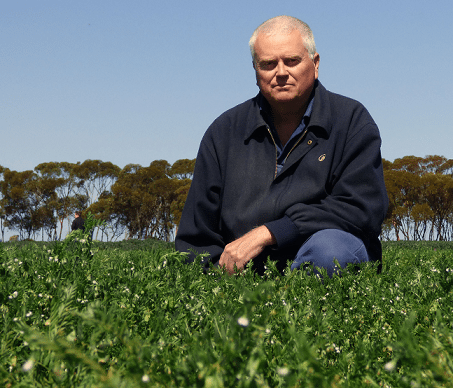LENTILS are still a good option for growers in Western Australia to consider in future cropping programs on medium to heavy textured soils, with 2017 trials producing seed yields of 1.5 tonnes/hectare or above.

WA DPIRD senior research officer Mark Seymour says growers should consider lentils as an option for the 2018 season.
WA Department of Primary Industries and Regional Development (DPIRD) trials, with Grains Research and Development Corporation (GRDC) investment, concluded that sowing lentils to achieve 100 to 110 plants per square metre in mid-April resulted in profitable yields.
DIPRD senior research officer Mark Seymour said ideal seeding rates were 45 kilograms/hectare for small seed types such as PBA Hurricane XT, 50kg/ha for medium sized varieties including PBA Bolt and 60kg/ha for PBA Jumbo2.
Research trials were sown at Dongara, Wittenoom Hills, Kumarl north of Salmon Gums, Grass Patch and Gnowangerup in April and May.
Mr Seymour said when comparing all Pulse Breeding Australia (PBA) variety performance, PBA Bolt was a consistent performer across all trial sites.
“PBA Bolt is the most popular lentil variety grown in WA, with alternative options of PBA Hurricane XT and PBA Jumbo2,” he said.
“The Grass Patch trial sown in mid-April was the highest yielding trial for PBA Bolt at 2.3t/ha, followed by 1.9t/ha at Wittenoom Hills.”
Mr Seymour said in the trials located in areas of southern WA, PBA Hurricane XT was noticeably slower growing than PBA Bolt, and yield was equal to or lower than PBA Bolt.
“PBA Hurricane XT is the best available option if growers are concerned about sulfonylurea residues or they are planning to use imazethapyr in-crop for increased weed control,” he said.
“PBA Jumbo2 has the best disease resistance of the varieties making it of particular interest to southern growers.
“PBA Jumbo2 produced similar yields to PBA Bolt, however, emergence was uneven, particularly on sodic soil sites.
“The increased disease resistance may outweigh any variable growth concerns.
“Lower yields across all varieties were observed at Kumarl due to frost and at Dongara and Gnowangerup as a result of delayed sowing and emergence.”
Source: GRDC
Grain Central: Get our free daily cropping news straight to your inbox – Click here

HAVE YOUR SAY